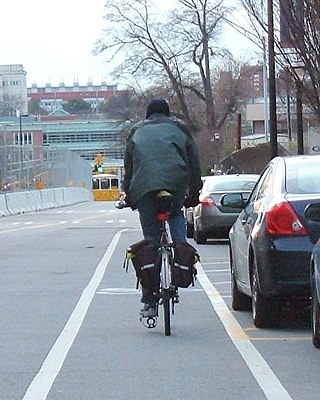
A bicycle rodeo is a clinic to teach children the skills and precautions to ride a bicycle safely.

A bicycle rodeo is a clinic to teach children the skills and precautions to ride a bicycle safely.
In the United States, Kiwanis clubs originated the idea of teaching bicycle safety to organized groups of children. They set up bicycle lectures which then became bicycle seminars. Eventually, a more hands on approach was used to teach the children and the term bicycle rodeo was adopted. This name is much more attractive to children and helped the events to grow in popularity. In Denmark a similar concept called mobil cykelbanes (mobile bicycle playgrounds) was introduced about 2012. [1]
Bicycle rodeos are usually run by local police departments. Police Chief Rosanne M. Sizer of the Portland, Oregon Police Department said, "It's important that our children understand bicycle safety. This is an opportunity for area youth to learn important skills and in the process get to know some of our bicycle, traffic, and reserve officers." [2] The Kiwanis clubs still run rodeos with the police departments. Others who run rodeos are schools, outdoor recreation companies, the Boy Scouts of America, State Farm Insurance, and large bicycle shops or sporting goods stores.

Bicycle Rodeos are usually for the age group of 4–13 years old. The activities that are provided are suitable for each age so that no one is bored during the event. Each rodeo usually begins with a short lecture on bicycle safety and is then followed by a written exam to test the child's knowledge of bicycle use. Each rodeo has some type of a road course; this is usually the children's favorite part of the entire day. Some rodeos have more funding which allows them to build a small town for the children to ride around in as if it were real. This small town is called Safety Town. Throughout the town there are real life situations such as traffic lights, stop signs, pedestrians crossing the streets, and road intersections. The children learn to handle riding their bikes in this life like setting. Rodeos are a popular place for businesses to come and set up booths to sell bike related products and give away gifts to the children. Many times local radio stations will broadcast their shows live from the rodeo and provide music to add to the experience.
In a typical bicycle rodeo there are eight different stations with chalk courses that the children have to master in order to pass the course. The objective of each course is to make sure that each child knows how to operate his or her bike correctly. The stations are: mounting and dismounting the bicycle, changing direction and turning in circles, steering through tight spaces, weaving, having the ability to stop quickly, turning around, riding the bicycle very slowly while maintaining balance, and learning to maneuver tight turns.
Every Bicycle rodeo has a safety course. Most rodeos begin the course with the safety check for both the rider and the bicycle because it is very important. The safety check for the rider is the helmet and bicycle fit. An ABC quick check is performed on the bicycle. The ABC quick check consists of checking for proper air in the tires, checking to see that the brakes work, and checking that the chains are on properly. [3]
Bicycle rodeo vary in what they offer. There are always plenty of fun things to do.[ citation needed ] After each child is finished with the safety course they are free to go around to the different booths to check out what they have. There is usually plenty of food and free prizes. A local bicycle shop might be giving away a bell or light for the bicycle. There might also be competitions held where the children can show off their newly learned skills. Some of the competitions may involve racing. Whatever activities a bicycle rodeo may offer, you can be sure it will be a safe and fun filled day.

Cycling, also, when on a two-wheeled bicycle, called bicycling or biking, is the use of cycles for transport, recreation, exercise or sport. People engaged in cycling are referred to as "cyclists", "bicyclists", or "bikers". Apart from two-wheeled bicycles, "cycling" also includes the riding of unicycles, tricycles, quadricycles, recumbent and similar human-powered vehicles (HPVs).

Critical Mass is a form of direct action in which people meet at a set location and time and travel as a group through their neighbourhoods on bikes. The idea is for people to group together to make it safe for each other to ride bicycles through their streets, based on the old adage: there's safety in numbers.

The penny-farthing, also known as a high wheel, high wheeler or ordinary, is an early type of bicycle. It was popular in the 1870s and 1880s, with its large front wheel providing high speeds and comfort.

Mountain biking is a sport of riding bicycles off-road, often over rough terrain, usually using specially designed mountain bikes. Mountain bikes share similarities with other bikes but incorporate features designed to enhance durability and performance in rough terrain, such as air or coil-sprung shocks used as suspension, larger and wider wheels and tires, stronger frame materials, and mechanically or hydraulically actuated disc brakes. Mountain biking can generally be broken down into five distinct categories: cross country, trail riding, all mountain, downhill, and freeride.

Utility cycling encompasses any cycling done simply as a means of transport rather than as a sport or leisure activity. It is the original and most common type of cycling in the world. Cycling mobility is one of the various types of private transport and a major part of individual mobility.

Zoobomb is a weekly bicycling activity in Portland, Oregon, United States during which participants ride bicycles rapidly downhill in the city's West Hills. Zoobomb began in 2002.

Countersteering is used by single-track vehicle operators, such as cyclists and motorcyclists, to initiate a turn toward a given direction by momentarily steering counter to the desired direction. To negotiate a turn successfully, the combined center of mass of the rider and the single-track vehicle must first be leaned in the direction of the turn, and steering briefly in the opposite direction causes that lean. The rider's action of countersteering is sometimes referred to as "giving a steering command".

Road bicycle racing is the cycle sport discipline of road cycling, held primarily on paved roads. Road racing is the most popular professional form of bicycle racing, in terms of numbers of competitors, events and spectators. The two most common competition formats are mass start events, where riders start simultaneously and race to a set finish point; and time trials, where individual riders or teams race a course alone against the clock. Stage races or "tours" take multiple days, and consist of several mass-start or time-trial stages ridden consecutively.

Vehicular cycling is the practice of riding bicycles on roads in a manner that is in accordance with the principles for driving in traffic, and in a way that places responsibility for safety on the individual.

Dooring is the act of opening a motor vehicle door into the path of another road user. Dooring can happen when a driver has parked or stopped to exit their vehicle, or when passengers egress from cars, taxis and rideshares into the path of a cyclist in an adjacent travel lane. The width of the door zone in which this can happen varies, depending upon the model of car one is passing. The zone can be almost zero for a vehicle with sliding or gull-wing doors or much larger for a truck. In many cities across the globe, doorings are among the most common and injurious bike-vehicle incidents. Any passing vehicle may also strike and damage a negligently opened or left open door, or injure or kill the exiting motorist or passenger.

Bicycle safety is the use of road traffic safety practices to reduce risk associated with cycling. Risk can be defined as the number of incidents occurring for a given amount of cycling. Some of this subject matter is hotly debated: for example, which types of cycling environment or cycling infrastructure is safest for cyclists. The merits of obeying the traffic laws and using bicycle lighting at night are less controversial. Wearing a bicycle helmet may reduce the chance of head injury in the event of a crash.

Motorcycle training teaches motorcycle riders the skills for riding on public roads. It is the equivalent of driver's education for car drivers. Training beyond basic qualification and licensing is available to those whose duty includes motorcycle riding, such as police, and additional rider courses are offered for street riding refreshers, sport riding, off-road techniques, and developing competitive skills for the motorcycle racetrack.

A bicycle trailer is a motorless wheeled frame with a hitch system for transporting cargo by bicycle. It can greatly increase a bike's cargo capacity, allowing point-to-point haulage of objects up to 4 cubic yards in volume that weigh as much as half a ton.

Freestyle motocross is a variation on the sport of motocross in which motorcycle riders attempt to impress judges with jumps and stunts.
Auxiliary constables or reserve constables are unpaid citizens in Canada who volunteer their time and skills to a police force. They are uniformed, unarmed members who perform a similar role to their UK counterparts in the Special Constabulary. Their main function is to supplement the police force with additional manpower, with duties varying by appointment, geographical location and the needs of the specific detachment/department.

A bicycle handlebar is the steering control for bicycles. It is the equivalent of a tiller for vehicles and vessels, as it is most often directly mechanically linked to a pivoting front wheel via a stem which in turn attaches it to the fork. Besides steering, handlebars also often support a portion of the rider's weight, depending on their riding position, and provide a convenient mounting place for brake levers, shift levers, cyclocomputers, bells, etc.

The Street Trust is a 501(c)(3) non-profit advocacy organization based in Portland, Oregon, United States. The Street Trust advocates for the safety and ease of biking, walking and riding public transit in communities. The organization does legislative work at the statewide and national levels and endorses legislation and ballot measures. It successfully lobbied Portland's mass transit company, TriMet, to accommodate bicycles on buses and prevailed in a lawsuit to uphold Oregon's Bicycle Bill.

Mountain bike trials, also known as observed trials, is a discipline of mountain biking in which the rider attempts to pass through an obstacle course without setting foot to ground. Derived from motorcycle trials, it originated in Catalonia, Spain as trialsín and is said to have been invented by Pere Pi, the father of Ot Pi, a world champion motorcycle trials rider. Pi's father had wanted his son to learn motorcycle trials by practicing on an ordinary bicycle.

Bicycle theft is the crime of stealing a bicycle. It is a common crime due to the relative ease of reselling bicycles, which have a large second-hand market. This makes the crime attractive to those needing to obtain currency quickly, such as people with substance addictions. Bicycles are also easily accessible, often being locked up outside in public places in urban areas. Despite the developed market of bicycle locks, it is estimated that millions of bicycles are stolen every year. Thieves use a variety of methods to bypass locks, including taking advantage of bicycle owners' poor locking practices. Bicycle owners can take action to reduce the chances of theft, including utilising facilities such as bicycle lockers and parking racks.